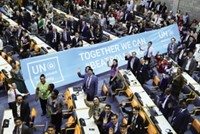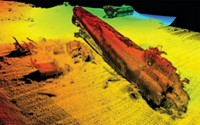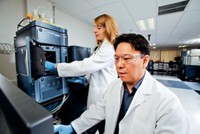Advertisement
Grab your lab coat. Let's get started
Welcome!
Welcome!
Create an account below to get 6 C&EN articles per month, receive newsletters and more - all free.
It seems this is your first time logging in online. Please enter the following information to continue.
As an ACS member you automatically get access to this site. All we need is few more details to create your reading experience.
Not you? Sign in with a different account.
Not you? Sign in with a different account.
ERROR 1
ERROR 1
ERROR 2
ERROR 2
ERROR 2
ERROR 2
ERROR 2
Password and Confirm password must match.
If you have an ACS member number, please enter it here so we can link this account to your membership. (optional)
ERROR 2
ACS values your privacy. By submitting your information, you are gaining access to C&EN and subscribing to our weekly newsletter. We use the information you provide to make your reading experience better, and we will never sell your data to third party members.
Instrumentation
Inside Greenpeace’s analytical laboratories
How a small team of scientists with a tiny budget is making a global impact
by Alex Scott
August 17, 2022
| A version of this story appeared in
Volume 100, Issue 29

There is a sharp smell of bleach as rivulets of foamy water wash over paving slabs. A contractor is using a chlorine-based solution to spray clean the exterior of the Innovation Centre, the home of Greenpeace Research Laboratories, Greenpeace’s chemistry labs, at the University of Exeter. The irony is deep because Greenpeace has been campaigning against the industrial production of chlorine for decades. David Santillo, a biologist and senior scientist, shakes his head in exasperation and reels off a number of less environmentally harmful alternatives the contractor might have used.
As tenants on a university campus, Greenpeace researchers don’t get to have everything their way. Their labs receive annual funding of just a few hundred thousand dollars—provided by Greenpeace members—which must cover everything, including rent, scientific instruments, and the salaries of eight full-time-equivalent scientists. Staffers are acutely aware that they have to devise projects with the potential to make a big impact at low cost.
Santillo and his team tend to focus their efforts on analyzing specific problems, such as pollution at a certain site, widespread contamination by specific compounds like per- and polyfluoroalkyl substances, or hazardous consumer products. “We have to be very strategic,” Santillo says.
At the same time, the wider demands on Greenpeace’s scientists—most of whom have been in their roles for more than a decade—are substantial. They are expected to liaise with Greenpeace colleagues, the media, policy makers, and scientists from other organizations. To demonstrate good scientific practice, Greenpeace encourages its scientists to publish their findings in peer-reviewed journals. Most important, it wants them to deliver scientific data capable of driving environmental policy changes at the highest level.
The range of these responsibilities exceeds that of the employees of most environmental groups. But most of those groups don’t have a working laboratory. “What makes Greenpeace a little bit different,” Santillo says, “is this direct connection to the lab.”
Paul Johnston set up Greenpeace Research Laboratories in 1987 and has been its principal scientist since 1992. Johnston is a biologist with a PhD in the toxic effects of selenium on aquatic invertebrates. Greenpeace saw a need to create the group because it had been unable to obtain independent information on pollution caused by large industrial facilities.
One of Johnston’s first tasks was to take water samples and analyze them using a gas chromatography/mass spectrometry (GC/MS) instrument that was aboard a Greenpeace ship. “At the time, it was more or less unsuccessful running a GC/MS on a small boat,” says Santillo, who has a PhD in marine microbial ecology. Instead, Greenpeace established a lab on dry land within Queen Mary University of London. In 1992 the research group accepted the offer of a new home on the University of Exeter’s main campus.
Today, Santillo and his team operate two labs in the Innovation Centre. One is a wet lab crammed with glassware—rather than less sustainable single-use plastics—while the second is bursting with modern analytical instruments. There are four GC/MS machines, including one for liquid-liquid and liquid-solid extractions and another for thermal desorption for analysis that includes air quality. The lab also has an inductively coupled plasma mass spectrometer for analyzing metals and a liquid chromatograph/mass spectrometer, which the scientists use for analyzing pesticides and pharmaceuticals. In addition, the lab contains Fourier transform infrared (FT-IR) spectroscopy instruments that “we might use for analyzing larger pieces of plastic,” Santillo says.
“It’s a huge range of equipment,” he says. “We could occupy probably 10 people easily working full-time on the instruments, but we just don’t have those human resources. So we’ve got to be really tight on what we can do—and what we can’t.”
The instrumentation lab would look like any other if not for all the machines and lights being turned off when not in use. Being frugal with energy is just part of the mindset here. Another must-do is designing projects to avoid solvents that may be harmful to the environment. Thinking early on about which solvent to use makes this a simple exercise, according to Kevin Brigden, the science team’s metals chemist.
Other team members include Iryna Labunska, whose core field is organic analytical chemistry, and Mengjiao Wang, whose specialty is environmental forensics. The team’s satellite staff includes air quality forecaster Aidan Farrow, who is based in London, and Reyes Tirado, a plant ecologist working on sustainable agriculture projects, mostly in Spain.
As part of its commitment to support research across the university, Greenpeace has located one of its FT-IR systems in the school of biosciences. The research group has also been successful in cutting deals with instrument suppliers. “We do acknowledge suppliers in publications, and we talk at their events,” Santillo says. “We’ve always been very good at negotiating.”
He admits that he could probably earn more elsewhere. “If someone was to come along and say, ‘Do you want to come and work in academia for double the money or in pharmaceuticals for triple the money?’ I would say no,” Santillo says. Greenpeace is where he believes he can derive the greatest satisfaction by making the biggest positive impact.
Rather than Greenpeace scientists moving on to higher-paid industry jobs, the direction of travel might even be reversed. Ildiko Kriston, an analytical chemist, joined Greenpeace in 2020 after working for a number of pharmaceutical companies.
To keep a lid on costs, Santillo and his colleagues rely on Greenpeace’s worldwide network of volunteers and employees. These people are trained to follow robust scientific methods when collecting materials, which are then sent to the Exeter labs. When the team there lacks the instruments or capacity for analysis, Greenpeace contracts it out to commercial labs.

Santillo flags a string of research efforts from the Exeter labs that have changed government policies for the better. They include a project in the 1990s that brought new evidence to the European Commission and to regulators in the US about the risks posed by some phthalates in polyvinyl chloride toys. Agencies subsequently placed controls on the products.
“Nobody at that point was looking at this,” Santillo says. “It was the early days of us doing GC/MS in a qualitative screening mode. But we were able to quantify a range of different phthalates, some of which were already known to be toxic.” He adds that “these were things designed for children to chew on for hours on end, and in some cases they contained 70% phthalates by weight, which could leach out of the plastic. The industry knew their properties, and yet this just wasn’t getting the visibility. So we published those data.”
The science team has since chalked up many successes. In one of its most recent projects, it published findings on the environmental impact of dumping plastic waste in Turkey. The waste originated in European countries, including the UK and Germany, according to Brigden. He and others on the team had roles in the initial project design and the characterization of plastic and soil samples from Turkey.
The science team’s report, which was presented to Turkish authorities, identified high levels of hazardous chemicals, including the heavy metals cadmium and lead. The government has begun cleanup and is implementing restrictions on imports of plastic waste, Brigden says.
Other recent studies include a characterization of plastic contamination in the Galapagos Islands and the threat it poses to marine species there (Sci. Total Environ. 2021, DOI:10.1016/j.scitotenv.2021.147704).
“One of the very satisfying things about the job I get to do is seeing real change that can come about from our research,” Brigden says. Responses to the group’s published research—even a response as dramatic as a government policy revision—can take form “in a matter of weeks,” he says.
While not everyone agrees with Greenpeace’s campaigns, scientists generally don’t assume the organization’s research is biased, Brigden says.
This acceptance by the science community hasn’t always been the case. “In the early days there was deep skepticism about Greenpeace doing science,” Santillo says. “There was an element in the ’90s of disbelief that we even had equipment and that we did analysis.”
But many scientists are still frustrated by Greenpeace’s interpretation of science, notably its campaign to ban genetically modified crops. In 2016, 107 Nobel laureates signed an open letter urging Greenpeace to end that initiative. Despite the backlash, it maintains its position. On its website, Greenpeace states that genetically modified crops “encourage corporate control of the food chain and pesticide-heavy industrial farming.”
The group’s long-term initiative to stop industrial production of chlorine has also drawn the ire of scientists—including many who read C&EN.
Greenpeace’s scientific findings are still challenged by other scientists on occasion, but once the organization has shared its data and methodology, “invariably the people have come back to us and said, ‘Oh, no, actually you are right,’ ” Brigden says. “Underneath it all, we are making sure there is scientific rigor. Greenpeace is an organization guided by science.”
CORRECTION:
This story was updated on Aug. 18, 2022, to correct three errors. An image caption incorrectly stated David Santillo's position. He is a senior scientist, not head of Greenpeace's labs. Second, the story misstated the reason for locating one of its Fourier transform infrared instruments in the school of biosciences. It is to support research across the university, not to save rent. Third, Aidan Farrow's affiliation was corrected. He is based in London, not at the University of Hertfordshire.





Join the conversation
Contact the reporter
Submit a Letter to the Editor for publication
Engage with us on Twitter